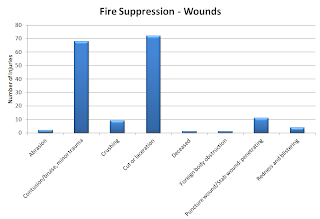Last week we discussed wounds occurring when not wearing gloves. Not wearing gloves, and other PPE for that matter, is often a violation of departmental Standard Operating Procedures (SOPs). Many reported injuries could have been avoided had the injured party followed their department’s SOPs. This week we’ll focus our blog post on the importance of SOPs and how you can decrease injuries by making sure you and your team follow them on every call.
SOP Issues
The commission requires every regulated entity to adopt several SOPs. These SOPs are required to ensure the safety of all fire fighters. Unfortunately, we have seen a few areas where firefighters were not following these SOPs. Incorporating SOPs into training is a good way to build habits leading to safer behavior on the fire ground.
In 2011, among the injuries reported, you reported 27 documented SOP violations. The majority of them involve the injured parties not wearing Personal Protective Equipment (PPE) – often missing gloves.
Check out some examples of Wounds occurring when the injured party was not following departmental SOPs:
“Individual got burned due to not wearing PPE during grass fire. The department has SOP's regarding wildland fires and PPE that should be used. The department is addressing this internally.”
“He has PPE's but was not wearing the coat. He was the driver of the pumper and was rolling up the red line and was pulling it over the wire fence. He does not have wildland PPE's. He failed to comply as he should have had his coat on. The department will address internal SOP issues.”
Fight like you train
Do what you can to make sure your department provides quality training experiences, by incorporating department SOPs. These should realistically reflect situations your team will face. Similarly, when you are on scene, react the way you were trained to react. Don’t cut corners in training, or on the scene. Make sure proper PPE are worn and SOPs are followed during and after training – ALWAYS. Make it habit, so that when the time comes no one gets injured or finds themselves in a near-miss situation.
Write effective SOPs for your department
Learn to write applicable and realistic SOPs and you’ll get higher adherence rates. Additionally, you’ll have safer firefighters who develop better work habits. Check out these tips and contact the TCFP Library for other departments’ examples of our required SOPs.
Learn to write applicable and realistic SOPs and you’ll get higher adherence rates. Additionally, you’ll have safer firefighters who develop better work habits. Check out these tips and contact the TCFP Library for other departments’ examples of our required SOPs.
- Firefighter Close Calls Policy & SOP Program
- Developing Effective Standard Operating Procedures (USFA)
- The Simple Approach to Writing Effective SOPs (Fire Engineering)
Follow up from last month: Last month we discussed a near-miss that occurred in Hutto, TX. Firehouse Magazine’s continued coverage of that incident is in their January issue. They address the issue of having quality SOPs, and training to them. If you need a copy of the articles, contact the TCFP Library.
Are your department’s SOPs realistic?
Do your department’s SOPs play an important part in training?





